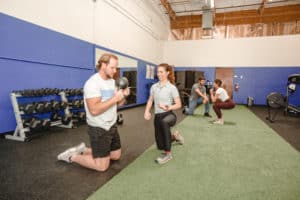
Do you find that you have not made the gains that you would like in the gym? Or perhaps, you just feel like you’re in a work-out rut, doing the same boring routine again and again?
Are you having a hard time figuring out how to program your workout routine or figuring out what muscle groups or exercises to prioritize in your workout routine?
You’re not alone. Most people have questions regarding their workout routines ranging from sets and reps, to when they should be performing cardio and how much.
Below are some of the most frequently asked questions we get from our clients, and answers that can help optimize your workout routines and help you achieve your goals.
1. “How should I begin my workout, cardio or weights?”
Cardio is great for building endurance and working different energy systems (such as heart health), but if your goal is to gain strength, do cardio after your strength training session. You want to go into your strength training session with all of your available strength, rather than getting fatigued from cardio first.
A lot of times patients do cardio at the beginning to “warmup”. Instead, try doing an active warmup before you lift. Some glute activation exercises, caterpillar walks, and the world’s greatest stretch are a good way to prime the body for exercise without depleting your strength.
If you want some ideas or inspiration on your exercises, be sure to check out our YouTube Channel.
2. “What is better, for my workout routine, free weights or machines?”
If you have an acute injury or weakness machines are beneficial because a lot of times you are singling out one muscle, but for functional strength free weights are a better choice.
With free weights, you are recruiting more muscles. You are working to develop the deep stabilizing muscles in your hips, shoulders, and throughout your body. You are able to practice using your entire body, and multiple muscle groups, which improves the ability to generate and transfer force.
It’s important to have functional strength components in your workout routine. This simply means exercises that mimic real world movements. Using a machine that operates on a fixed track limits how dynamic the workout will be.
A very important consideration when lifting free-weights, is lifting mechanics.
3. “How long should I rest between sets?”
The rest time between sets is dependent on your goal. If you are looking to make strength gains, take up to 3 minutes in between sets and fully recover. You want to go into each set feeling 100% and not just going to failure.
You’ll find that your body needs this rest when you’re training with loads high enough to increase your strength.
If you’re seeking endurance, or even hypertrophy (size), rest periods may be as short as 30-45 seconds.
4. “What rep/set scheme should I be using?”
Rep/set schemes are dependent on your goals. If you are looking for pure strength keep the reps in between 1-6. When building strength we want to lift heavy, so that means fewer reps and more time in between sets.
If you’re training for muscle growth/hypertrophy, keep your reps in between 8-12. More reps and decreased rest time will increase local fatigue and metabolic demands, which in turn helps your body to build larger muscles.
If you’re training for endurance, you’ll want repetitions in the 12-15+ range.
The most important thing to remember here is in regards to intensity (weight). You need to select a weight that makes it difficult to accomplish the last 1-2 repetitions of each set. You should not use a weight that you can do 10-12 reps of, and only do 6 reps, then call it strength training.
5. “What day is leg day?”
Trick question! EVERYDAY IS LEG DAY!
Our glutes, quads, hamstrings, and calves are vital muscles that keep us moving. These muscles should not be singled out to just one day.
When you think about it, a squat is essentially getting up from a seated position and a deadlift is picking something up from the ground (such as groceries or a planter in your backyard).
Now, this does not mean that every day you’re going to lift heavy weights to train your legs, but simply to point out that even when you are choosing to do cardio on non-lifting days, you are still working your legs.
Training your legs functionally a couple of days a week and strength training 1-2 days a week is appropriate.
6. “How should I set up my workout program?”
One of our most asked questions is, when and how often patients do certain lifts. One of my personal favorite splits for strength training, is to do upper body pull/lower body push 2 days a week. Then upper body push lower/lower body pull the other 2 days. This gives you 4 lifting days with a rest day in between.
For example, on an upper body pull/lower body push day you could pair pull-ups (upper body pull), or some type of row with some variation of a squat (lower body push).
The next day, which would be your upper body push/lower body pull, try pairing a bench (upper body push) or overhead press with some type of deadlift, or Romanian deadlift (lower body pull).
This is just one of so many variations and splits. Other schemes include:
- Supersets
- Circuits
- Mini-Circuits
- One Major Muscle Group Each Day
- And many more…
Your workout split depends on your goals. It’s important to have times where you push yourself and times where you let off the gas. You also need something that’s going to keep it interesting and a way to hold yourself accountable.
Many people get stuck in a rut, get bored, and stop working out. If that’s you and you need to spice up your workout, it’s time to get some help!
Still have questions?
The Doctors of Physical Therapy are experts in movement and exercise and can help you achieve your goals.
We can Teach you about your body and what approach to your exercise routine would work best for you. We can help you develop a plan of attack to achieve your goals for a strong body, and an active, healthy lifestyle.
Click the button below to go to our contact page and send us a message, letting us know how you’d like to be helped.



